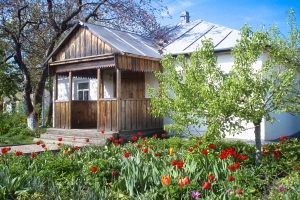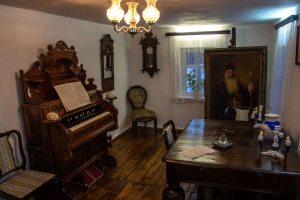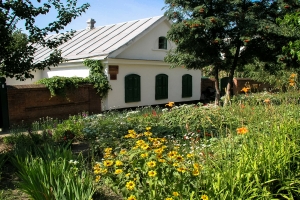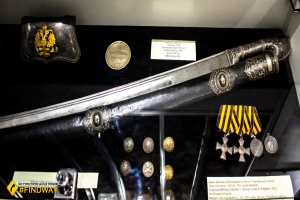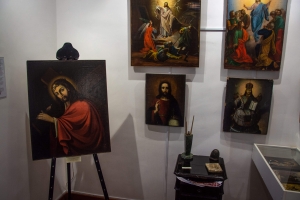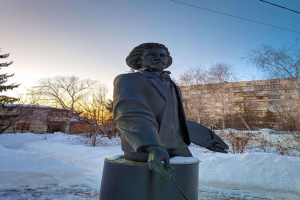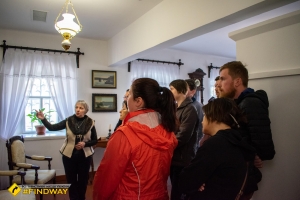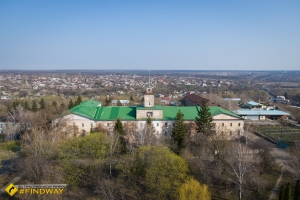History of the museum
The memorial museum is located in the house of the time of military settlements, where from October 1876 to September 1877 Illya Repin lived with his family. The main attention in the exposition of the memorial museum is paid to the Chuguiv period in the life and work of I. Repin, as well as to the close ties of the artist with Ukraine.
The memorial museum is located in the house of the time of military settlements, where from October 1876 to September 1877 Illya Repin lived with his family. The main attention in the exposition of the memorial museum is paid to the Chuguiv period in the life and work of I. Repin, as well as to the close ties of the artist with Ukraine.
The first attempts to organize a museum of Illya Repin in his homeland were made in 1914 when the public of Chuguev and Kharkiv took such an initiative. Authorities planned the house for the museum and allocated funds for its acquisition, but with the outbreak of World War I it receded into the background. The second attempt to build a museum was made in 1936. Much work has been done to gather information about the artist's family, his childhood and adolescence. But again prevented the beginning of the war. In 1941, the works were stopped and the collected collection was lost.
Repin Art and Memorial Museum was established on August 3, 1969 in accordance with the Resolution of the Council of Ministers of the USSR № 2240 of May 14, 1968. The first visitors of the memorial house-museum were received on August 3, 1969 on the eve of the one hundred and twenty-fifth anniversary of the artist's birth. The museum has 11 original works by Repin, including drawings, etchings and paintings. On the territory of the museum there is a memorial house, which belonged to Repin's parents, and an outbuilding, in which Repin arranged his workshop after returning from France.
In the window of one of the rooms you can see objects that were found in this house when the museum was created: antique coins, a pipe, tongs for sugar, a beetle "servant" to remove shoes and a large clay tile that previously covered the roof of this house. In the first hall you can look in the mirror in a beautiful carved frame, which once looked like an artist. The exposition of this room also presents I. Repin's personal belongings.
In the photos, the museum can be seen in the photos of the visit of a delegation of I. Repin's descendants, who now live in France and came to Chuguiv to see the places where Repin's grandmother's house used to be and the cemetery where I. Repin's mother Tatiana is buried.
The artist's childhood
I. Repin's childhood took place in the house of Repin's grandmother. The house was large and spacious, divided into 2 parts and had 2 entrances. In one part there were bright rooms where children were not even allowed, and the second part seemed to the guests. That is, grandmother kept an inn. Horses grazed in the territory, and the Repin family huddled in a small wooden outbuilding on their grandmother's estate. It was there on August 5, 1844, the future artist was born. Grandma's house has not survived, but in the museum it can be seen in a drawing by N. Onadsky. Soon the mother hires builders and oversees the construction of the new house. It is being built there, in Osynivka, on the edge of the city, on the very shore of the Siversky Donets. The whole family moved there, from here Repin went to St. Petersburg, to the Academy of Arts.
When her own house was built, the artist's mother, Tetyana Stepanivna, discovered the likeness of a school. She gathered more than 10 boys there, whom she taught to read and write there. The first students were their own children, daughter Ustya and son Illya. Repin mentioned that he and his sister were the smartest and grabbed everything on the fly.
In the window of one of the rooms you can see objects that were found in this house when the museum was created: antique coins, a pipe, tongs for sugar, a beetle "servant" to remove shoes and a large clay tile that previously covered the roof of this house. In the first hall you can look in the mirror in a beautiful carved frame, which once looked like an artist. The exposition of this room also presents I. Repin's personal belongings.
In the photos, the museum can be seen in the photos of the visit of a delegation of I. Repin's descendants, who now live in France and came to Chuguiv to see the places where Repin's grandmother's house used to be and the cemetery where I. Repin's mother Tatiana is buried.
The artist's childhood
I. Repin's childhood took place in the house of Repin's grandmother. The house was large and spacious, divided into 2 parts and had 2 entrances. In one part there were bright rooms where children were not even allowed, and the second part seemed to the guests. That is, grandmother kept an inn. Horses grazed in the territory, and the Repin family huddled in a small wooden outbuilding on their grandmother's estate. It was there on August 5, 1844, the future artist was born. Grandma's house has not survived, but in the museum it can be seen in a drawing by N. Onadsky. Soon the mother hires builders and oversees the construction of the new house. It is being built there, in Osynivka, on the edge of the city, on the very shore of the Siversky Donets. The whole family moved there, from here Repin went to St. Petersburg, to the Academy of Arts.
When her own house was built, the artist's mother, Tetyana Stepanivna, discovered the likeness of a school. She gathered more than 10 boys there, whom she taught to read and write there. The first students were their own children, daughter Ustya and son Illya. Repin mentioned that he and his sister were the smartest and grabbed everything on the fly.
But the house of the artist's parents has not survived either, and a memorial sign has been established in its place. Some objects from the Repin House in Osynivka have been preserved in the museum. The artist's father, Yuhim Repin, served in the army for 27 years. He was a forager, that is, engaged in the procurement of fodder for horses.
The window shows a weapon that is also directly related to the military history of the city: a sword of one of the officers of the Chuguiv Uhlan Regiment and a cuirassier's pallage, as uncle of Repin was an officer of this regiment, a Caucasian-type checker, gunpowder storage, etc.
After receiving a good home education, he soon became a student, in his words, "the most desirable place to study, where they draw in ink and paint with watercolors" - School of Surveyors. The school was located in the building of military headquarters. Repin mentioned that the Chuguiv School of Topographers was provided with the best materials from London, quality paper and Newtonian paints. You can guess how many drawings were made at that time, but only 2 have survived - they are in the collection of the Tretyakov Gallery. Training at the School of Topographers was not completed. In 1857, Emperor Alexander II decided to abolish military settlements, and in this regard disbanded the corps of military surveyors. Then I. Repin became a student of one of the best artists of Chuguiv - I. Bunakov. There was a very wide choice of teachers, and he explains his choice by the fact that Bunakov once studied "Raphael" Chuguev - Leontiy Persanov. But he did not study for long, a year and a half later he surpassed his teacher and became an independent master. Repin participates in the painting of churches, writes images, makes iconostasis and already receives money for it. At the age of 17 he was already a well-known icon painter. The exposition of the room presents the work done during Bunakov's studies - "Christ in the crown of thorns", when he was about 13-14 years old. Here in the room you can see a corner of the icon painter: a stone grater, a form for gluing decorative details, brushes, pencils.
Here you can see old-fashioned icons and portraits of locals, which was very popular at the time. I. Repin received 100 rubles for the painting of the Orphan Church of the Voronizh Province, and already believed that with such capital it was possible to conquer the capital.
The window shows a weapon that is also directly related to the military history of the city: a sword of one of the officers of the Chuguiv Uhlan Regiment and a cuirassier's pallage, as uncle of Repin was an officer of this regiment, a Caucasian-type checker, gunpowder storage, etc.
After receiving a good home education, he soon became a student, in his words, "the most desirable place to study, where they draw in ink and paint with watercolors" - School of Surveyors. The school was located in the building of military headquarters. Repin mentioned that the Chuguiv School of Topographers was provided with the best materials from London, quality paper and Newtonian paints. You can guess how many drawings were made at that time, but only 2 have survived - they are in the collection of the Tretyakov Gallery. Training at the School of Topographers was not completed. In 1857, Emperor Alexander II decided to abolish military settlements, and in this regard disbanded the corps of military surveyors. Then I. Repin became a student of one of the best artists of Chuguiv - I. Bunakov. There was a very wide choice of teachers, and he explains his choice by the fact that Bunakov once studied "Raphael" Chuguev - Leontiy Persanov. But he did not study for long, a year and a half later he surpassed his teacher and became an independent master. Repin participates in the painting of churches, writes images, makes iconostasis and already receives money for it. At the age of 17 he was already a well-known icon painter. The exposition of the room presents the work done during Bunakov's studies - "Christ in the crown of thorns", when he was about 13-14 years old. Here in the room you can see a corner of the icon painter: a stone grater, a form for gluing decorative details, brushes, pencils.
Here you can see old-fashioned icons and portraits of locals, which was very popular at the time. I. Repin received 100 rubles for the painting of the Orphan Church of the Voronizh Province, and already believed that with such capital it was possible to conquer the capital.
Life in St. Petersburg
In the fall, at the age of 19, he went to St. Petersburg. But soon he will be disappointed - Repin is not admitted to the Academy of Arts. But he knew he would never return. He is hired for a variety of jobs - he paints the roofs of houses, crews, iron buckets, everything to rent a room. And he rented a room from the St. Petersburg architect A. Petrov. And the landlord gave a very good advice to the guest - to learn to draw in a society of art promotion, which soon Repin does. In the exhibition you can see the first drawing of Repin in this school - a pencil drawing of a plaster cast of a burdock leaf, for which he received the highest grade. And in 3 months he became a non-collegiate, and in 3 months a full-fledged student of the Academy of Arts. He graduated from the Academy with a diploma work - the painting "Resurrection of the daughter of Jairus", for which he received the highest award of the Academy - the Grand Gold Medal. This medal entitles the graduate to travel abroad. The artist can stay in the countries of Western Europe for 6 years and at the same time the Academy pays him a pension. However, Repin did not leave immediately, at first he wanted to finish the started canvas "Burlaki on the Volga". This painting was commissioned by Repin prince Volodymyr, Vice President of the Academy of Arts. After buying a painting, the prince often complained that the room was often empty without a painting - it was so popular at the time that the painting was often taken to exhibitions.
European tour
When Repin is going to go to Europe with his wife and daughter, the first thing he does is visit the world exhibition in Vienna, where his work was exhibited. The painting "Burlaki on the Volga" brought worldwide fame to a very young artist. Then the trip lay through Italy, where, as he said, "you can forget about painting”. With great enthusiasm, but soon realizes that the French can learn a lot, but you can also be impersonal, still need to work on home soil. From the first days of his stay in France in each letter sent to their homeland was anguish. He dreams of a speedy return and makes plans for future life. In the exposition were paintings, which were made in Paris - two portraits of Ukrainian girls.
Preparing to go to his homeland, he begins his painting "Savko". But when an artist inspired by work on this topic shares his ideas with his friends, he suddenly receives sharp criticism. At first, Repin even wants to destroy this canvas, but the order of Emperor Alexander III does not allow him to do so. And the painting is delivered from Paris to St. Petersburg, gets into the collection of the emperor and then becomes the property of the State Russian Museum.
Cossacks in Repin's paintings
In the exposition you can also see the first sketch of the future painting "Cossacks write a letter to the Turkish sultan", 1877. At that time, Repin visited his friend, a famous industrialist and philanthropist Sava Mamontov. And there, among friends, he heard the story of how the Turkish Sultan Muhammad 4 appealed to the Cossacks for obedience, and they in response to the Sultan decided to send a letter. The letter turned out to be bold and of course the artist knew the text of this letter well, because even in Chuguiv it was copied and passed from hand to hand. But there, in the suburbs of Moscow, under the influence of an artistic reading of the test by the professor of the St. Petersburg conservatory Repin took a pencil and this first drawing appeared on the album sheet, which became fundamental to the future work. Afterwards, he did a great job on this painting, went to Zaporizhzhya Sich, drew about 1,000 sketches. But the finished painting was presented at his solo exhibition in St. Petersburg 13 years later. And when Emperor Alexander III saw the painting, he decided that it should become part of his collection, and bought it from the artist, paying a record 35,000 rubles in gold.
Some of them give to buy an estate in Zdravnevo, Belarus. He is rebuilding a wooden house with a tower according to the project of his father-in-law-architect. And soon he takes his whole family to Zdravnevo. Almost 7 years of Repin's life are connected with Belarus.
But the theme of the Cossacks did not leave the artist for a long time. Six years after the first painting, another version of the painting of the same name appears - "Cossacks write a letter to the Turkish sultan." But this is not a copy and not a repetition - this is a completely independent work,which Repin's friend P. Tretyakov buys for his collection. For many years, this painting is in the Tretyakov Gallery in Moscow, and then was transferred to the Kharkiv Art Museum. And now it is exhibited in the Repin hall of this museum, in Kharkiv.
As K. Chukovsky said: "Drawing for Repin was like breathing" and wherever he came, just visiting someone or during ceremonial events, he always took with him an album, a pencil and made sketches.
In the fall, at the age of 19, he went to St. Petersburg. But soon he will be disappointed - Repin is not admitted to the Academy of Arts. But he knew he would never return. He is hired for a variety of jobs - he paints the roofs of houses, crews, iron buckets, everything to rent a room. And he rented a room from the St. Petersburg architect A. Petrov. And the landlord gave a very good advice to the guest - to learn to draw in a society of art promotion, which soon Repin does. In the exhibition you can see the first drawing of Repin in this school - a pencil drawing of a plaster cast of a burdock leaf, for which he received the highest grade. And in 3 months he became a non-collegiate, and in 3 months a full-fledged student of the Academy of Arts. He graduated from the Academy with a diploma work - the painting "Resurrection of the daughter of Jairus", for which he received the highest award of the Academy - the Grand Gold Medal. This medal entitles the graduate to travel abroad. The artist can stay in the countries of Western Europe for 6 years and at the same time the Academy pays him a pension. However, Repin did not leave immediately, at first he wanted to finish the started canvas "Burlaki on the Volga". This painting was commissioned by Repin prince Volodymyr, Vice President of the Academy of Arts. After buying a painting, the prince often complained that the room was often empty without a painting - it was so popular at the time that the painting was often taken to exhibitions.
European tour
When Repin is going to go to Europe with his wife and daughter, the first thing he does is visit the world exhibition in Vienna, where his work was exhibited. The painting "Burlaki on the Volga" brought worldwide fame to a very young artist. Then the trip lay through Italy, where, as he said, "you can forget about painting”. With great enthusiasm, but soon realizes that the French can learn a lot, but you can also be impersonal, still need to work on home soil. From the first days of his stay in France in each letter sent to their homeland was anguish. He dreams of a speedy return and makes plans for future life. In the exposition were paintings, which were made in Paris - two portraits of Ukrainian girls.
Preparing to go to his homeland, he begins his painting "Savko". But when an artist inspired by work on this topic shares his ideas with his friends, he suddenly receives sharp criticism. At first, Repin even wants to destroy this canvas, but the order of Emperor Alexander III does not allow him to do so. And the painting is delivered from Paris to St. Petersburg, gets into the collection of the emperor and then becomes the property of the State Russian Museum.
Cossacks in Repin's paintings
In the exposition you can also see the first sketch of the future painting "Cossacks write a letter to the Turkish sultan", 1877. At that time, Repin visited his friend, a famous industrialist and philanthropist Sava Mamontov. And there, among friends, he heard the story of how the Turkish Sultan Muhammad 4 appealed to the Cossacks for obedience, and they in response to the Sultan decided to send a letter. The letter turned out to be bold and of course the artist knew the text of this letter well, because even in Chuguiv it was copied and passed from hand to hand. But there, in the suburbs of Moscow, under the influence of an artistic reading of the test by the professor of the St. Petersburg conservatory Repin took a pencil and this first drawing appeared on the album sheet, which became fundamental to the future work. Afterwards, he did a great job on this painting, went to Zaporizhzhya Sich, drew about 1,000 sketches. But the finished painting was presented at his solo exhibition in St. Petersburg 13 years later. And when Emperor Alexander III saw the painting, he decided that it should become part of his collection, and bought it from the artist, paying a record 35,000 rubles in gold.
Some of them give to buy an estate in Zdravnevo, Belarus. He is rebuilding a wooden house with a tower according to the project of his father-in-law-architect. And soon he takes his whole family to Zdravnevo. Almost 7 years of Repin's life are connected with Belarus.
But the theme of the Cossacks did not leave the artist for a long time. Six years after the first painting, another version of the painting of the same name appears - "Cossacks write a letter to the Turkish sultan." But this is not a copy and not a repetition - this is a completely independent work,which Repin's friend P. Tretyakov buys for his collection. For many years, this painting is in the Tretyakov Gallery in Moscow, and then was transferred to the Kharkiv Art Museum. And now it is exhibited in the Repin hall of this museum, in Kharkiv.
As K. Chukovsky said: "Drawing for Repin was like breathing" and wherever he came, just visiting someone or during ceremonial events, he always took with him an album, a pencil and made sketches.
A unfeasible artist's dream
The last time the artist visited Chuguiv was in 1924. The museum presents photos from Repin's last visit to his hometown. His main goal was the revival of art in his homeland, namely the construction of the Business Yard. He remembered that even in the days of military settlements in Chuguiv there were business yards where talented people gathered. Repin prepared a plan of such a yard with workshops, homesteads, playgrounds for sports and a park. From his personal savings, Repin allocated money for its construction, and the city authorities provided 6 acres of land. But the events of the First World War disrupted all the plans of the artist, the Business Yard was never built. Only before the 100th anniversary of Repin, a park named after Repin was built on the same site.
The adornment of next room is portrait made by Repin's brush - the wife of the Moscow manufacturer Elizabeth Sapozhnikova and a portrait of his favorite student Marianna Veryovkina. Here is a table and chairs at which Illya Repin sat during his last visit to his hometown. On the table near the samovar you can also see a thin porcelain cup, it has blue flowers, gold letters and the inscription "Happy Angel's Day", Repin gave it to his godson's wife for her birthday. In the sacred corner of the room there is an icon - especially revered in Chuguiv Volodymyr Icon of the Mother of God created by a mature icon painter 19-year-old Illya Repin. Etudes by M. Alistov and M. Berkas are also presented here.
The museum's gift for the opening day is a painting by V. Makovsky "Politics". With this painter Repin participated in many traveling exhibitions.
Repin's workshop
The artist's workshop is a separate house, which is part of the tour. This house also belonged to the artist's parents, it was an ordinary wooden outbuilding, which was covered with straw and in the brightest room of Repin's outbuilding and arranged his workshop. He worked within these walls for a year.
The last time the artist visited Chuguiv was in 1924. The museum presents photos from Repin's last visit to his hometown. His main goal was the revival of art in his homeland, namely the construction of the Business Yard. He remembered that even in the days of military settlements in Chuguiv there were business yards where talented people gathered. Repin prepared a plan of such a yard with workshops, homesteads, playgrounds for sports and a park. From his personal savings, Repin allocated money for its construction, and the city authorities provided 6 acres of land. But the events of the First World War disrupted all the plans of the artist, the Business Yard was never built. Only before the 100th anniversary of Repin, a park named after Repin was built on the same site.
The adornment of next room is portrait made by Repin's brush - the wife of the Moscow manufacturer Elizabeth Sapozhnikova and a portrait of his favorite student Marianna Veryovkina. Here is a table and chairs at which Illya Repin sat during his last visit to his hometown. On the table near the samovar you can also see a thin porcelain cup, it has blue flowers, gold letters and the inscription "Happy Angel's Day", Repin gave it to his godson's wife for her birthday. In the sacred corner of the room there is an icon - especially revered in Chuguiv Volodymyr Icon of the Mother of God created by a mature icon painter 19-year-old Illya Repin. Etudes by M. Alistov and M. Berkas are also presented here.
The museum's gift for the opening day is a painting by V. Makovsky "Politics". With this painter Repin participated in many traveling exhibitions.
Repin's workshop
The artist's workshop is a separate house, which is part of the tour. This house also belonged to the artist's parents, it was an ordinary wooden outbuilding, which was covered with straw and in the brightest room of Repin's outbuilding and arranged his workshop. He worked within these walls for a year.
During this time, a large number of works were written, portraits of children, friends and relatives were created. Here he worked on genre paintings and for the first time turned to the theme of the procession. The first painting on this theme was called "The procession in the oak forest", on the wall you can see a reproduction of this painting. He continued his work in Moscow and St. Petersburg, and it lasted for 47 years. And in 1922 he almost completely rewrote the canvas, leaving only a colorful figure in the foreground - Deacon Ivan Ulanov. He served as a deacon in the Intercession Cathedral. But when Repin starts working on the portrait, he calls it a protodiac. The portrait was completed soon and the artist did not leave it in Chuguiv, but sent to Moscow and offered it to his friend Tretyakov. Pavlo Mykhailovych, bargaining, bought this portrait, and never parted with it again. Therefore Repin's "Protodeacon" to this day is in the Tretyakov Gallery in Moscow. Here, in the museum, is a copy of the artist-restorer A. Rybnikov. In the same room you will see a rather unusual musical instrument - the harmonium. Keyboard-wind instrument that works on the principle of the body. The Harmony was made in America in the 19th century, is still in working order and is not accidentally located here. Illya Yukhimovich loved music very much. And he even admitted that if he did not have to hear music for a long time, he was sad and wrote many of his works to musical accompaniment.
This room also features a portrait of Trokhim Chaplygin, I. Repin's cousin. He was 8 years older than Illya, but still a boy had a very strong friendship in childhood. Repin left many fond memories of his cousin affectionately calling him Tron`ka. One of the memories relates to the Christmas holidays that the boys spent together. He came to visit a little, but not empty-handed, and brought a package with him, a box in it, and watercolor paints and brushes in the box. Until the age of six, Illya had never seen paints. The boys wanted to paint right away, but there was no album or sheet of paper in the house. Then they took the Alphabet from Ustya's older sister and began to paint colorless contour pictures. Repin mentioned that the first picture in front of his eyes begins to come to life. The watermelon near the letter "a" becomes so ripe and juicy that you want to eat it - the artist wrote. Therefore, when the holidays were over, and Trohim had to leave the house of the Repins, Illya began to worry and even cry. And to somehow comfort his younger brother, Tronko leaves him brushes and paints. From this point it begins having a passion for drawing that lasts a lifetime. Many years later, I. Repin will write "if it weren't Tronka, I might not have become an artist."
In a small room, or recreation room, where I. Repin's wife, Vira Oleksiivna, once spent her time. She could sit on the couch, have a cup of coffee or stand by the mirror. On one of the windows is a posthumous cast of the artist's right hand. If you pay attention, you can see that between the thumb and index finger is a huge gap, no muscle. Repin worked very hard and the constant tension of his right arm led to the drying of this muscle. Moreover, the hand began to hurt, and began to refuse the thumb and the artist was forced to see a doctor, which was not typical for him. And they forbade him to work. But not imagining himself without a favorite thing Repin begins to learn to draw with his left hand. For more than 20 years of his life I. Repin worked with his left hand.
In the kitchen you can see a large narrow oven with various kitchen utensils, stags and holders, and near the window is a large wooden table. It has the first items for ironing clothes - a rolling pin and a ruble. Dish shelf with plates from France, bottles for alcoholic drinks and small vials for medicines. In the red corner of the room is an icon of an unknown Chuguiv master depicting Illya - the prophet. The future artist received his name in honor of this saint.
Life on the shores of the Gulf of Finland
On the wall you can also see a life portrait of the artist. Repin was 72 years old when the sculptor Mikhail Blukh came to his estate Penata on the shores of the Gulf of Finland and made this portrait. Repin is still full of vitality and creativity.
He lived a long life. He died at the age of 86, on September 29, 1930. While living on his estate in Penati on the shores of the Gulf of Finland, 3 years before his death he asked permission to be buried on his own estate. And such a place was Chuguiv Mountain. Repin named the hill in memory of his hometown and ordered to bury himself on this hill.
How to get there?
It is best to get to the city of Chuguiv by bus. Buses run every 20 minutes, from the bus station to the metro station "Industrialna". Shuttle buses go to Chuguev №1472t, №1940. Upon arrival at the bus station in Chuguiv to the museum you have to walk. It will be enough to walk 200 m down Kharkivska Street and turn right onto the museum street, after 300 m you will be there.
In a small room, or recreation room, where I. Repin's wife, Vira Oleksiivna, once spent her time. She could sit on the couch, have a cup of coffee or stand by the mirror. On one of the windows is a posthumous cast of the artist's right hand. If you pay attention, you can see that between the thumb and index finger is a huge gap, no muscle. Repin worked very hard and the constant tension of his right arm led to the drying of this muscle. Moreover, the hand began to hurt, and began to refuse the thumb and the artist was forced to see a doctor, which was not typical for him. And they forbade him to work. But not imagining himself without a favorite thing Repin begins to learn to draw with his left hand. For more than 20 years of his life I. Repin worked with his left hand.
In the kitchen you can see a large narrow oven with various kitchen utensils, stags and holders, and near the window is a large wooden table. It has the first items for ironing clothes - a rolling pin and a ruble. Dish shelf with plates from France, bottles for alcoholic drinks and small vials for medicines. In the red corner of the room is an icon of an unknown Chuguiv master depicting Illya - the prophet. The future artist received his name in honor of this saint.
Life on the shores of the Gulf of Finland
On the wall you can also see a life portrait of the artist. Repin was 72 years old when the sculptor Mikhail Blukh came to his estate Penata on the shores of the Gulf of Finland and made this portrait. Repin is still full of vitality and creativity.
He lived a long life. He died at the age of 86, on September 29, 1930. While living on his estate in Penati on the shores of the Gulf of Finland, 3 years before his death he asked permission to be buried on his own estate. And such a place was Chuguiv Mountain. Repin named the hill in memory of his hometown and ordered to bury himself on this hill.
How to get there?
It is best to get to the city of Chuguiv by bus. Buses run every 20 minutes, from the bus station to the metro station "Industrialna". Shuttle buses go to Chuguev №1472t, №1940. Upon arrival at the bus station in Chuguiv to the museum you have to walk. It will be enough to walk 200 m down Kharkivska Street and turn right onto the museum street, after 300 m you will be there.
Translated by: Anhelina Leshak
Interesting places of this region (3)
JoomShopping Download & Support




